List of Roman emperors

Roman Emperors and Empresses were rulers of the Roman Empire, wielding power over its citizens and military. The empire was developed as the Roman Republic invaded and occupied most of Europe and portions of northern Africa and western Asia. Under the republic, regions of the empire were ruled by provincial governors answerable to and authorised by the "Senate and People of Rome". Rome and its senate were ruled by a variety of magistrates – of whom the consuls were the most powerful. The republic ended, and the emperors were created, when these magistrates became legally and practically subservient to one citizen with power over all other magistrates. Augustus, the first emperor, was careful to maintain the facade of republican rule, taking no specific title for his position[1] and calling the concentration of magisterial power Princeps Senatus (the first man of the senate).[1] This style of government lasted for 300 years, and is thus called the Principate era. The modern word 'emperor' derives from the title imperator, which was granted by an army to a successful general; during the initial phase of the empire, it still had to be earned by the 'Princeps'. The term emperor is a modern construction, used when describing rulers of the Roman Empire because it emphasises the strong links between the ruler and the army (on whose support the ruler's power depended), and does not discriminate between the personal styles of rule and titles in different phases of the Empire.
In the late 3rd century, after the Crisis of the Third Century, Diocletian formalised and embellished the recent manner of imperial rule, establishing the so-called 'Dominate' period of the Roman Empire. This was characterised by the explicit increase of authority in the person of the Emperor, and the use of the style 'Dominus Noster' ('Our Lord'). The rise of powerful Barbarian tribes along the borders of the empire and the challenge they posed to defense of far-flung borders and unstable imperial succession led Diocletian to experiment with sharing imperial titles and responsibilities among several individuals - a partial reversion to pre-Augustian Roman traditions. For nearly two centuries thereafter there was often more than one emperor at a time, frequently dividing the administration of the vast territories between them. As Henry Moss warned, "Yet it is important to remember that in the eyes of contemporaries the Empire was still one and indivisible. It is false to the ideas of this time to speak of 'the Eastern and Western Empire'; the two halves of Empire were thought of as 'the Eastern, or Western parts' (partes orientis vel occidentis.)"[2] However, after the death of Theodosius I (395), the split became firmly entrenched (see: Western and Eastern)[3] The last pretense of such division was formally ended by Zeno after the death of Julius Nepos in 480. For the remaining thousand years of Roman history there would only ever be one legitimate senior emperor, ruling from Constantinople and maintaining claim to the increasingly unstable territories in the west. After 480, multiple claims to be the imperial title of Augustus (or Basileus for Greek speakers) necessarily meant civil war, although the experiment with designating junior emperors (called now Caesars), usually to indicate the intended successor, occasionally reappeared.
The Empire and chain of emperors continued until the death of Constantine XI and the capture of Constantinople by the Ottoman Empire in 1453.[4] The use of the terms "Byzantium," "Byzantine Empire," and "Byzantine Emperor" to refer to the medieval period of the Empire has been common, but not universal, among Western scholars since the 18th century, and continues to be a subject of specialist debate today.[5]
Legitimacy
The emperors listed in this article are those generally agreed to have been 'legitimate' emperors, and who appear in published regnal lists.[6][7][8] The word 'legitimate' is used by most authors, but usually without clear definition, perhaps not surprisingly, since the emperorship was itself rather vaguely defined legally. In Augustus' original formulation, the princeps was selected by either the Senate or "the people" of Rome, but quite quickly the legions became an acknowledged stand-in for "the people." A person could be proclaimed as emperor by their troops or by "the mob" in the street, but in theory needed to be confirmed by the Senate. The coercion that frequently resulted was implied in this formulation. Furthermore, a sitting emperor was empowered to name a successor and take him on as apprentice in government and in that case the Senate had no role to play, although it sometimes did when a successor lacked the power to inhibit bids by rival claimants. By the medieval (or "Byzantine") period, the very definition of the Senate became vague as well, adding to the complication.[9]
Lists of legitimate emperors are therefore partly influenced by the subjective views of those compiling them, and also partly by historical convention. Many of the 'legitimate' emperors listed here acceded to the position by usurpation, and many 'illegitimate' claimants had a legitimate claim to the position. Historically, the following criteria have been used to derive emperor lists:
- Any individual who undisputedly ruled the whole Empire, at some point, is a 'legitimate emperor'(1).
- Any individual who was nominated as heir or co-emperor by a legitimate emperor (1), and who succeeded to rule in his own right, is a legitimate emperor (2).
- Where there were multiple claimants, and none were legitimate heirs, the claimant accepted by the Roman Senate as emperor is the legitimate emperor (3), at least during the Principate.
So for instance, Aurelian, though acceding to the throne by usurpation, was the sole and undisputed monarch between 270–275 AD, and thus was a legitimate emperor. Gallienus, though not in control of the whole Empire, and plagued by other claimants, was the legitimate heir of (the legitimate emperor) Valerian. Claudius Gothicus, though acceding illegally, and not in control of the whole Empire, was the only claimant accepted by the Senate, and thus, for his reign, was the legitimate emperor. Equally, during the Year of the Four Emperors, all claimants, though not undisputed, were at some point accepted by the Senate and are thus included; conversely, during the Year of the Five Emperors neither Pescennius Niger nor Clodius Albinus were accepted by the Senate, and are thus not included. There are a few examples where individuals were made co-emperor, but never wielded power in their own right (typically the child of an emperor); these emperors are legitimate, but are not included in regnal lists, and in this article are listed together with the 'senior' emperor.
Emperors after 395
After 395, the list of emperors in the East is based on the same general criteria, with the exception that the emperor only had to be in undisputed control of the Eastern part of the empire, or be the legitimate heir of the Eastern emperor.
The situation in the West is more complex. Throughout the final years of the Western Empire (395–480) the Eastern emperor was considered the senior emperor, and a Western emperor was only legitimate if recognized as such by the Eastern emperor. Furthermore, after 455 the Western emperor ceased to be a relevant figure and there was sometimes no claimant at all. For the sake of historical completeness, all Western Emperors after 455 are included in this list, even if they were not recognized by the Eastern Empire;[10] some of these technically illegitimate emperors are included in regnal lists, while others are not. For instance, Romulus Augustulus was technically a usurper who ruled only the Italian peninsula and was never legally recognized. However, he was traditionally considered the "last Roman Emperor" by 18th and 19th century western scholars and his overthrow by Odoacer used as the marking point between historical epochs, and as such he is usually included in regnal lists. However, modern scholarship has confirmed that Romulus Augustulus' predecessor, Julius Nepos continued to rule as Emperor in the other Western holdings and as a figurehead for Odoacer's rule in Italy until Nepos' death in 480. Since the question of what constitutes an emperor can be ambiguous, and dating the "fall of the Western Empire" arbitrary, this list includes details of both figures.
The Principate
Julio-Claudian dynasty
| Portrait | Name | Birth | Succession | Reign | Death | Time in office |
|---|---|---|---|---|---|---|
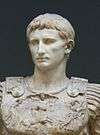 |
Augustus IMPERATOR CAESAR DIVI FILIVS AVGVSTVS |
September 23, 63 BC, Rome, Italia | Great-nephew and adopted son of Julius Caesar; became de facto emperor as a result of the 'first settlement' between himself and the Roman Senate. | January 16, 27 BC – August 19, 14 AD | August 19, 14 AD Natural causes or perhaps poisoning by his wife, Livia. |
40 years, 7 months and 3 days |
 |
Tiberius TIBERIVS IVLIVS CAESAR AVGVSTVS |
November 16, 42 BC, Rome | Natural son of Livia Drusilla, Augustus' third wife, by a previous marriage; stepbrother and third husband of Julia the Elder, daughter of Augustus; adopted by Augustus as his son and heir. | September 18, 14 AD – March 16, 37 AD | March 16, 37 AD Probably natural causes, possibly assassinated by Caligula |
22 years, 5 months and 27 days |
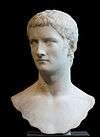 |
Caligula GAIVS IVLIVS CAESAR AVGVSTVS GERMANICVS |
August 31, 12 AD, Antium, Italia | Great-nephew and adoptive grandson of Tiberius; natural son of Germanicus; great-grandson of Augustus. | March 18, 37 AD – January 24, 41 AD | January 24, 41 AD Assassinated in a conspiracy involving senators and Praetorian Guards. |
3 years, 10 months and 6 days |
 |
Claudius TIBERIVS CLAVDIVS CAESAR AVGVSTVS GERMANICVS |
August 1, 10 BC, Lugdunum, Gallia Lugdunensis | Uncle of Caligula; brother of Germanicus; nephew of Tiberius; great-nephew and step-grandson of Augustus; proclaimed emperor by the Praetorian Guard. | January 25/26, 41 AD – October 13, 54 AD | October 13, 54 AD Probably poisoned by his wife Agrippina the Younger, in favour of her son Nero, possibly natural causes. |
13 years, 8 months and 18/19 days |
| Nero NERO CLAVDIVS CAESAR AVGVSTVS GERMANICVS |
December 15, 37 AD, Antium, Italia | Great-nephew, stepson, son-in-law and adopted son of Claudius; nephew of Caligula; great-great-nephew of Tiberius; grandson of Germanicus; great-great-grandson of Augustus | October 13, 54 AD – June 9, 68 AD | June 9, 68 AD Committed suicide after being declared a public enemy by the Senate. |
13 years, 7 months and 27 days | |
Year of the Four Emperors and Flavian dynasty
| Portrait | Name | Birth | Succession | Reign | Death | Time in office |
|---|---|---|---|---|---|---|
 |
Galba SERVIVS SVLPICIVS GALBA CAESAR AVGVSTVS |
December 24 3 BC, Near Terracina, Italia | Seized power after Nero's suicide, with support of the Spanish legions | June 8, 68 AD – January 15, 69 AD | January 15, 69 AD Murdered by Praetorian Guard in coup led by Otho. |
7 months and 7 days |
 |
Otho MARCVS SALVIVS OTHO CAESAR AVGVSTVS |
April 28, 32 AD, Ferentinum, Italia | Appointed by Praetorian Guard | January 15, 69 AD – April 16, 69 AD | April 16, 69 AD Committed suicide after losing Battle of Bedriacum to Vitellius |
3 months and 1 day (91 days) |
 |
Vitellius AVLVS VITELLIVS GERMANICVS AVGVSTVS |
September 24, 15 AD, Rome | Seized power with support of German Legions (in opposition to Galba/Otho) | April 17, 69 AD – December 20, 69 AD | December 20, 69 AD Murdered by Vespasian's troops |
8 months and 3 days |
 |
Vespasian TITVS FLAVIVS CAESAR VESPASIANVS AVGVSTVS |
November 17, 9 AD, Falacrine, Italia | Seized power with the support of the eastern Legions (in opposition to Vitellius) | December 21, 69 AD – June 24, 79 AD | June 24, 79 AD Natural causes |
9 years, 6 months and 3 days |
 |
Titus TITVS FLAVIVS CAESAR VESPASIANVS AVGVSTVS |
December 30, 39 AD, Rome | Son of Vespasian | June 24, 79 AD – September 13, 81 AD | September 13, 81 AD Natural causes (fever) |
2 years, 2 months and 20 days |
| |
Domitian TITVS FLAVIVS CAESAR DOMITIANVS AVGVSTVS |
October 24, 51 AD, Rome | Son of Vespasian | September 14, 81 AD – September 18, 96 AD | September 18, 96 AD Assassinated by court officials |
15 years and 4 days |
Nerva–Antonine dynasty
| Portrait | Name | Birth | Succession | Reign | Death | Time in office |
|---|---|---|---|---|---|---|
 |
Nerva MARCVS COCCEIVS NERVA CAESAR AVGVSTVS |
November 8, 30 AD, Narni, Italia | Appointed by the Senate | September 18, 96 AD – January 27, 98 AD | January 27, 98 AD Natural causes |
1 year, 4 months and 9 days |
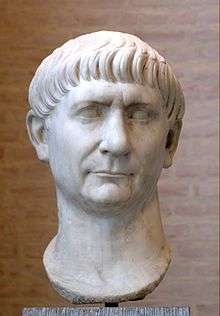 |
Trajan CAESAR MARCVS VLPIVS NERVA TRAIANVS AVGVSTVS |
September 18, 53 AD, Italica, Hispania Baetica | Adopted son and heir of Nerva | January 28, 98 AD – August 7, 117 AD | August 7, 117 AD Natural causes |
19 years, 6 months and 10 days |
 |
Hadrian CAESAR PVBLIVS AELIVS TRAIANVS HADRIANVS AVGVSTVS |
January 24, 76 AD, Italica, Hispania Baetica (or Rome) | Adopted son and heir of Trajan | August 11, 117 AD – July 10, 138 AD | July 10, 138 AD Natural causes |
20 years, 10 months and 30 days |
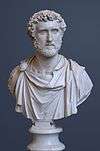 |
Antoninus Pius CAESAR TITVS AELIVS HADRIANVS ANTONINVS AVGVSTVS PIVS |
September 19, 86 AD, Near Lanuvium, Italia | Adopted son and heir of Hadrian | July 10, 138 AD – March 7, 161 AD | March 7, 161 AD Natural causes |
22 years, 6 months and 28 days |
 |
Marcus Aurelius CAESAR MARCVS AVRELIVS ANTONINVS AVGVSTVS |
April 26, 121 AD, Rome | Adopted son, son-in-law and heir of Antoninus Pius; Co-emperor with Lucius Verus until 169 AD | March 7, 161 AD – March 17, 180 AD | March 17, 180 AD Natural causes |
19 years and 10 days |
 |
Lucius Verus CAESAR LVCIVS AVRELIVS VERVS AVGVSTVS |
December 15, 130 AD, Rome | Adopted son and heir of Antoninus Pius and son-in-law of Marcus Aurelius; Co-emperor with Marcus Aurelius until death | March 7, 161 AD – ? March 169 AD | March 169 AD Natural causes (Plague) |
8 years |
 |
Commodus CAESAR MARCVS AVRELIVS COMMODVS ANTONINVS AVGVSTVS |
August 31, 161 AD, Lanuvium, Italia | Natural son of Marcus Aurelius; joint emperor from 177 AD | 177 AD – December 31, 192 AD | December 31, 192 AD Assassinated in palace, strangled to death |
3 years as joint emperor, 12 as sole emperor |
Year of the Five Emperors and Severan dynasty
| Portrait | Name | Birth | Succession | Reign | Death | Time in office |
|---|---|---|---|---|---|---|
| Pertinax CAESAR PVBLIVS HELVIVS PERTINAX AVGVSTVS |
August 1, 126 AD, Alba, Italia | Proclaimed emperor by Praetorian Guard | January 1, 193 AD – March 28, 193 AD | March 28, 193 AD Murdered by Praetorian Guard |
2 months and 27 days (86 days) | |
 |
Didius Julianus CAESAR MARCVS DIDIVS SEVERVS IVLIANVS AVGVSTVS |
133 or 137 AD, Milan, Italia | Won auction held by the Praetorian Guard for the position of emperor | March 28, 193 AD – June 1, 193 AD | June 1, 193 AD Executed on orders of the Senate |
2 months and 4 days (65 days) |
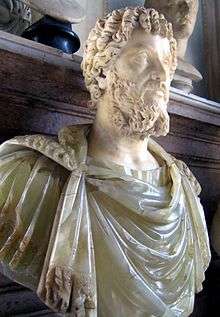 |
Septimius Severus CAESAR LVCIVS SEPTIMIVS SEVERVS PERTINAX AVGVSTVS |
April 11, 145 AD, Leptis Magna, Libya | Seized power with support of Pannonian legions[11] | April 9, 193 AD – February 4, 211 AD | February 4, 211 AD Natural causes |
17 years, 9 months and 26 days |
 |
Caracalla CAESAR MARCVS AVRELIVS SEVERVS ANTONINVS PIVS AVGVSTVS |
April 4, 188 AD, Lugdunum, Gallia Lugdunensis | Son of Septimius Severus; co-emperor with Severus from 198 AD; with Severus and Geta from 209 AD until February 211 AD; co-emperor with Geta until December 211 AD | 198 AD – April 8, 217 AD | April 8, 217 AD Murdered by a soldier as part of a conspiracy involving Macrinus |
13 years as joint emperor 10 months with Geta 6 years as sole emperor |
 |
Geta CAESAR PVBLIVS SEPTIMIVS GETA AVGVSTUS |
March 7, 189 AD, Rome | Son of Septimius Severus; co-emperor with Severus and Caracalla from 209 AD until February 211 AD; co-emperor with Caracalla until December 211 AD | 209 AD – December 26, 211 AD | December 19, 211 AD Murdered on the orders of Caracalla |
2 years as joint emperor 10 months with Caracalla |
 |
Macrinus MARCVS OPELLIVS SEVERVS MACRINVS AVGVSTVS PIVS FELIX with Diadumenian MARCVS OPELLIVS ANTONINVS DIADUMENIANVS |
c. 165 AD, Iol Caesarea, Mauretania | Praetorian Prefect to Caracalla, probably conspired to have Caracalla murdered and proclaimed himself emperor after Caracalla's death; appointed his son Diadumenian junior emperor in May 217 | April 11, 217 AD – June 8, 218 AD | June 8, 218 AD Both executed in favour of Elagabalus |
1 year, 1 months and 28 days |
_-_Musei_capitolini_-_Foto_Giovanni_Dall'Orto_-_15-08-2000.jpg) |
Elagabalus MARCVS AVRELIVS ANTONINVS AVGVSTVS |
c. 203 AD, Emesa, Syria | Grandson-in-law of Septimius Severus, alleged illegitimate son of Caracalla; proclaimed emperor by Syrian legions | June 8, 218 AD – March 11, 222 AD | March 11, 222 AD Murdered by Praetorian Guard |
3 years, 9 months and 3 days |
 |
Severus Alexander CAESAR MARCVS AVRELIVS SEVERVS ALEXANDER AVGVSTVS |
October 1, 208 AD, Arca Caesarea, Syria | Grandson-in-law of Septimius Severus, cousin and adoptive heir of Elagabalus | March 13, 222 AD – March 18, 235 AD | March 18, 235 AD Murdered by the army |
13 years and 5 days |
Crisis of the Third Century and Gordian dynasty
| Portrait | Name | Birth | Succession | Reign | Death | Time in office |
|---|---|---|---|---|---|---|
 |
Maximinus I CAESAR GAIVS IVLIVS VERVS MAXIMINVS AVGVSTVS |
c.173 AD, Thrace or Moesia | Proclaimed emperor by German legions after the murder of Severus Alexander | March 20, 235 AD – June 238 AD | June 238 AD Assassinated by Praetorian Guard |
3 years, 3 months |
 |
Gordian I CAESAR MARCVS ANTONIVS GORDIANVS SEMPRONIANVS AFRICANVS AVGVSTVS |
c. 159 AD, Phrygia? | Proclaimed emperor, whilst Pro-consul in Africa, during a revolt against Maximinus. Ruled jointly with his son Gordian II, and in opposition to Maximinus. Technically a usurper, but retrospectively legitimised by the accession of Gordian III | March 22, 238 AD – April 12, 238 AD | April 238 AD Committed suicide upon hearing of the death of Gordian II. |
21 days |
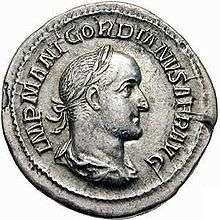 |
Gordian II CAESAR MARCVS ANTONIVS GORDIANVS SEMPRONIANVS ROMANVS AFRICANVS AVGVSTVS |
c. 192 AD, ? | Proclaimed emperor, alongside father Gordian I, in opposition to Maximinus by act of the Senate. | March 22, 238 AD – April 12, 238 AD | April 238 AD Killed during the Battle of Carthage, fighting a pro-Maximinus army |
21 days |
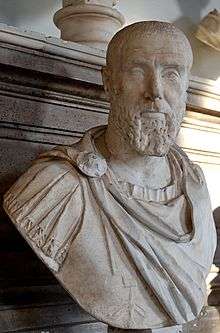 |
Pupienus CAESAR MARCVS CLODIVS PVPIENVS MAXIMVS AVGVSTVS |
c. 178 AD, ? | Proclaimed joint emperor with Balbinus by the Senate in opposition to Maximinus; later co-emperor with Balbinus. | April 22, 238 AD – July 29, 238 AD | July 29, 238 AD Assassinated by the Praetorian Guard |
3 months and 7 days |
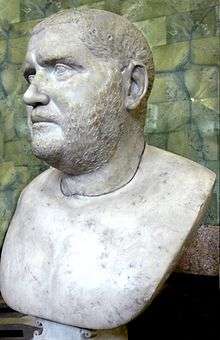 |
Balbinus CAESAR DECIMVS CAELIVS CALVINVS BALBINVS PIVS AVGVSTVS |
? | Proclaimed joint emperor with Pupienus by the Senate after death of Gordian I and II, in opposition to Maximinus; later co-emperor with Pupienus and Gordian III | April 22, 238 AD – July 29, 238 AD | July 29, 238 AD Assassinated by Praetorian Guard |
3 months and 7 days |
 |
Gordian III CAESAR MARCVS ANTONIVS GORDIANVS AVGVSTVS |
January 20, 225 AD, Rome | Proclaimed emperor by supporters of Gordian I and II, then by the Senate; joint emperor with Pupienus and Balbinus until July 238 AD. | April 22, 238 AD – February 11, 244 AD | February 11, 244 AD Unknown; possibly murdered on orders of Philip I |
5 years, 9 months and 20 days |
 |
Philip I CAESAR MARCVS IVLIVS PHILIPPVS AVGVSTVS with Philip II |
c. 204 AD, Shahba, Syria | Praetorian Prefect to Gordian III, took power after his death; made his son Philip II co-emperor in summer 247 AD | February 244 AD – September/October 249 AD | September/October 249 AD Killed in battle against Trajan Decius, near Verona |
5 years |
.jpg) |
Trajan Decius CAESAR GAIVS MESSIVS QVINTVS TRAIANVS DECIVS AVGVSTVS with Herennius Etruscus |
c. 201 AD, Budalia, Pannonia Inferior | Governor under Philip I; proclaimed emperor by Danubian legions and defeated Philip in battle; made his son Herennius Etruscus co-emperor in early 251 AD | September/ October 249 AD – June 251 AD | June 251 AD Both killed in the Battle of Abrittus fighting against the Goths |
2 years |
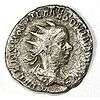 |
Hostilian CAESAR CAIVS VALENS HOSTILIANVS MESSIVS QVINTVS AVGVSTVS |
Sirmium | Son of Trajan Decius, accepted as heir by the Senate | June 251 AD – late 251 AD | September/October 251 AD Natural causes (plague) |
4–5 months |
| Trebonianus Gallus CAESAR GAIVS VIBIVS TREBONIANVS GALLVS AVGVSTVS with Volusianus |
206 AD, Italia | Governor of Moesia Superior, proclaimed emperor by Danubian legions after Trajan Decius's death (and in opposition to Hostilian); made his son Volusianus co-emperor in late 251 AD. | June 251 AD – August 253 AD | August 253 AD Assassinated by their own troops, in favour of Aemilian |
2 years | |
 |
Aemilian CAESAR MARCVS AEMILIVS AEMILIANVS AVGVSTVS |
c. 207 AD Africa | Governor of Moesia Superior, proclaimed emperor by Danubian legions after defeating the Goths; accepted as emperor after death of Gallus | August 253 AD – October 253 AD | September/October 253 AD Assassinated by his own troops, in favour of Valerian |
2 months |
| Valerian CAESAR PVBLIVS LICINIVS VALERIANVS AVGVSTVS |
c. 195 AD | Governor of Noricum and Raetia, proclaimed emperor by Rhine legions after death of Gallus; accepted as emperor after death of Aemilian | October 253 AD – 260 AD | After 260 AD Captured in Battle of Edessa against Persians, died in captivity |
7 years | |
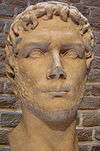 |
Gallienus CAESAR PVBLIVS LICINIVS EGNATIVS GALLIENVS AVGVSTVS with Saloninus |
218 AD | Son of Valerian, made co-emperor in 253 AD; his son Saloninus is very briefly co-emperor in c. July 260 before assassination by Postumus. | October 253 AD – September 268 AD | September 268 AD Murdered at Aquileia by his own commanders. |
15 years |
 |
Claudius Gothicus CAESAR MARCVS AVRELIVS CLAVDIVS AVGVSTVS |
May 10, 213 AD/214 AD, Sirmium | Victorious general at Battle of Naissus, seized power after Gallienus's death | September 268 AD – January 270 AD | January 270 AD Natural causes (plague) |
1 year, 4 months |
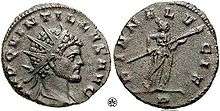 |
Quintillus CAESAR MARCVS AVRELIVS CLAVDIVS QVINTILLVS AVGVSTVS |
?, Sirmium | Brother of Claudius Gothicus, seized power after his death | January 270 AD – 270 AD | 270 AD Unclear; possibly suicide or murder |
Unknown |
| Aurelian CAESAR LVCIVS DOMITIVS AVRELIANVS AVGVSTVS |
September 9, 214 AD/215 AD, Sirmium | Proclaimed emperor by Danubian legions after Claudius II's death, in opposition to Quintillus | September(?) 270 AD – September 275 AD | September 275 AD Assassinated by Praetorian Guard |
5 years | |
 |
Tacitus CAESAR MARCVS CLAVDIVS TACITVS AVGVSTVS |
c. 200, Interamna Nahars, Italia | Elected by the Senate to replace Aurelian, after a short interregnum | September 25, 275 AD – June 276 AD | June 276 AD Natural causes (possibly assassinated) |
9 months |
| Florian CAESAR MARCVS ANNIVS FLORIANVS AVGVSTVS |
? | Brother of Tacitus, elected by the army in the west to replace him | June 276 AD – September? 276 AD | September? 276 AD Assassinated by his own troops, in favour of Probus |
3 months | |
 |
Probus CAESAR MARCVS AVRELIVS PROBVS AVGVSTVS |
232 AD, Sirmium | Governor of the eastern provinces, proclaimed emperor by Danubian legions in opposition to Florian | September? 276 AD – September/ October 282 AD | September/ October 282 AD Assassinated by his own troops, in favour of Carus |
6 years |
 |
Carus CAESAR MARCVS AVRELIVS CARVS AVGVSTVS |
c. 230 AD, Narbo, Gallia Narbonensis | Praetorian Prefect to Probus; seized power either before or after Probus was murdered | September/ October 282 AD – late July/ early August 283 AD | Late July/early August 283 AD Natural causes? (Possibly killed by lightning) |
10–11 months |
 |
Numerian CAESAR MARCVS AVRELIVS NVMERIVS NVMERIANVS AVGVSTVS |
? | Son of Carus, succeeded him jointly with his brother Carinus | Late July/early August 283 AD – 284 AD? | 284 AD Unclear; possibly assassinated |
1 year |
| Carinus CAESAR MARCVS AVRELIVS CARINVS AVGVSTVS |
? | Son of Carus, succeeded him jointly with his brother Numerian | Late July/early August 283 AD – 285 AD | 285 AD Died in battle against Diocletian? |
2 years |
The Dominate
Tetrarchy and Constantinian dynasty
| Portrait | Name | Birth | Succession | Reign | Death | Time in office |
|---|---|---|---|---|---|---|
_-_Foto_G._Dall'Orto_28-5-2006.jpg) |
Diocletian CAESAR GAIVS AVRELIVS VALERIVS DIOCLETIANVS AVGVSTVS |
c. December 22, 244 AD, Salona | Proclaimed emperor by army after death of Numerian, and in opposition to Carinus; adopted Maximian as senior co-emperor in 286 AD | November 20, 284 AD – May 1, 305 AD | 3 December 311 AD Abdicated; died of natural causes in Aspalatos |
20 years, 5 months and 11 days |
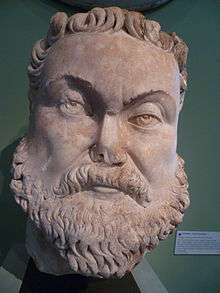 |
Maximian CAESAR MARCVS AVRELIVS VALERIVS MAXIMIANVS AVGVSTVS |
c. 250 AD, near Sirmium, Pannonia | Adopted as senior co-emperor ('Augustus') in the west by Diocletian in 286 AD | April 1, 286 AD – May 1, 305 AD | 310 AD Abdicated with Diocletian; twice tried to regain throne with, and then from Maxentius; captured by Constantine I and committed suicide at his behest |
19 years and 1 month |
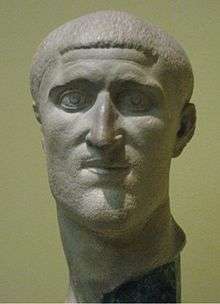 |
Constantius I CAESAR GAIVS FLAVIVS VALERIVS CONSTANTIVS AVGVSTVS |
March 31 c. 250 AD, Dardania, Moesia | Adopted as junior co-emperor ('Caesar') and heir by Maximian in 293 AD | May 1, 305 AD – July 25, 306 AD | 306 AD Natural causes |
1 year, 2 months and 24 days |
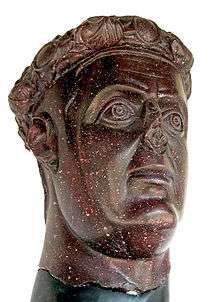 |
Galerius CAESAR GALERIVS VALERIVS MAXIMIANVS AVGVSTVS |
c. 260 AD, Felix Romuliana, Moesia Superior | Adopted as junior co-emperor ('Caesar') and heir by Diocletian in 293 AD. Also son-in-law of Diocletian. | May 1, 305 AD – May 311 AD | 311 AD Natural causes |
6 years |
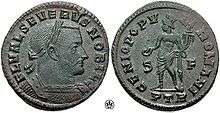 |
Severus II FLAVIVS VALERIVS SEVERVS AVGVSTVS |
? | Adopted as junior co-emperor ('Caesar') and heir by Constantius I Chlorus in 305 AD; succeeded as Augustus in 306; opposed by Maxentius and Constantine I | Summer 306 AD – March/ April 307 AD | September 16, 307 AD Captured by Maxentius and forced to commit suicide (or murdered) |
1 year |
 |
Constantine I CAESAR FLAVIVS VALERIVS AVRELIVS CONSTANTINVS AVGVSTVS |
February 27 c. 272 AD, Naissus, Moesia Superior | Son of Constantius I Chlorus, proclaimed emperor by his father's troops; accepted as Caesar (west) by Galerius in 306 AD; promoted to Augustus (west) in 307 AD by Maximian after death of Severus II; refused relegation to Caesar in 309 AD | July 25, 306 AD – May 22, 337 AD | May 22, 337 AD Natural causes |
30 years, 9 months and 27 days |
 |
Maxentius MARCVS AVRELIVS VALERIVS MAXENTIVS AVGVSTVS |
c. 278 AD, ? | Son of Maximian, seized power in 306 after death of Constantius I Chlorus, in opposition to Severus and Constantine I; made Caesar (west) by Maximian in 307 AD after the death of Severus | October 28, 306 AD – October 28, 312 AD | October 28, 312 AD Died at the Battle of the Milvian Bridge, against Constantine I |
6 years |
 |
Maximinus II CAESAR GALERIVS VALERIVS MAXIMINVS AVGVSTVS |
November 20 c. 270 AD, Dacia Aureliana | Nephew of Galerius, adopted as Caesar and his heir in 305 AD; succeeded as Augustus (shared with Licinius I) in 311 AD | May 1, 311 AD – July/August 313 AD | July/August 313 AD Defeated in civil war against Licinius I; probably committed suicide thereafter |
2 years |
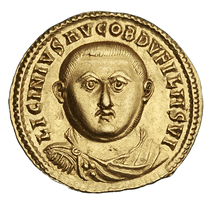 |
Licinius I CAESAR GAIVS VALERIVS LICINIVS AVGVSTVS with Valerius Valens Martinian |
c. 250 AD, Felix Romuliana, Moesia Superior | Son-in-law of Constantius Chlorus, appointed Augustus in the west by Galerius in 308 AD, in opposition to Maxentius; became Augustus in the east in 311 AD after the death of Galerius (shared with Maximinus II); defeated Maximinus in civil war to become sole eastern Augustus in 313 AD; appointed Valerius Valens in 317 AD, and Martinian in 324 AD as western Augustus, in opposition to Constantine, both being executed within weeks. | November 11, 308 AD – September 18, 324 AD | 325 AD Defeated in civil war against Constantine I in 324 AD and captured; executed on the orders of Constantine the next year |
15 years, 10 months and 7 days |
 |
Constantine II CAESAR FLAVIVS CLAVDIVS CONSTANTINVS AVGVSTVS |
316 AD, Arelate, Gallia Narbonensis | Son of Constantine I; appointed Caesar in 317 AD, succeeded as joint Augustus with his brothers Constantius II and Constans I | May 22, 337 AD – 340 AD | 340 AD Died in battle against Constans I |
3 years |
.jpg) |
Constantius II CAESAR FLAVIVS IVLIVS CONSTANTIVS AVGVSTVS |
August 7, 317 AD, Sirmium, Pannonia | Son of Constantine I; succeeded as joint Augustus with his brothers Constantine II and Constans I; sole emperor from 350 AD | May 22, 337 AD – November 3, 361 AD | 361 AD Natural causes |
24 years, 5 months and 12 days |
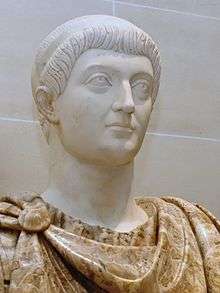 |
Constans I CAESAR FLAVIVS IVLIVS CONSTANS AVGVSTVS |
320 AD, ? | Son of Constantine I; succeeded as joint Augustus with his brothers Constantine II and Constantius II | May 22, 337 AD – 350 AD | 350 AD Assassinated on the orders of the usurper Magnentius |
13 years |
 |
Vetranio | ?, Moesia | General of Constans I, proclaimed Caesar against Magnentius and temporarily accepted as Augustus of the west by Constantius II. | March 1, 350 – December 25, 350 AD | c. 356 As a private citizen, after abdication. |
9 months and 24 days |
-CNG.jpg) |
Julian II CAESAR FLAVIVS CLAVDIVS IVLIANVS AVGVSTVS |
331 AD/332 AD, Constantinople, Thracia | Cousin of Constantius II; made Caesar of the west in 355 AD; proclaimed Augustus by his troops in 360; sole emperor after the death of Constantius | February 360 AD – June 26, 363 AD | June 26, 363 AD Mortally wounded in battle |
3 years |
 |
Jovian CAESAR FLAVIVS IOVIANVS AVGVSTVS |
331 AD, Singidunum, Moesia | General of Julian's army; proclaimed emperor by the troops on Julian's death | June 26, 363 AD – February 17, 364 AD | February 17, 364 AD Natural causes (suffocated on fumes) |
7 months and 22 days |
Valentinian dynasty
| Portrait | Name | Birth | Succession | Reign | Death | Time in office |
|---|---|---|---|---|---|---|
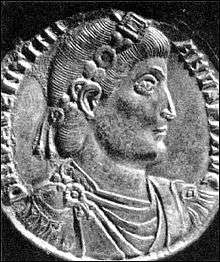 |
Valentinian I FLAVIVS VALENTINIANVS AVGVSTVS |
321 AD, Cibalae, Pannonia | Elected to replace Jovian by the army | February 26, 364 AD – November 17, 375 AD | November 17, 375 AD Natural causes |
11 years, 8 months and 22 days |
 |
Valens FLAVIVS IVLIVS VALENS AVGVSTVS |
328 AD, Cibalae, Pannonia | Brother of Valentinian I, appointed co-augustus (for the east) by him | March 28, 364 AD – August 9, 378 AD | August 9, 378 AD Killed in Battle of Adrianople against the Goths |
14 years, 4 months and 12 days |
 |
Gratian FLAVIVS GRATIANVS AVGVSTVS |
April 18/May 23, 359 AD, Sirmium, Pannonia | Son of Valentinian I, appointed 'junior' Augustus by him in 367, became 'senior' augustus (for the west) after Valentinian's death. | August 4, 367 AD – August 25, 383 AD | August 25, 383 AD Murdered by rebellious army faction |
16 years and 21 days |
| Valentinian II FLAVIVS VALENTINIANVS INVICTVS AVGVSTVS |
371 AD, Milan, Italia | Son of Valentinian I, proclaimed emperor by Pannonian army after Valentinian's death; accepted as co-Augustus for the west by Gratian | November 17, 375 AD – May 15, 392 AD | May 15, 392 AD Unclear; possibly murdered or committed suicide |
16 years, 5 months and 28 days |
Theodosian dynasty
| Portrait | Name | Birth | Succession | Reign | Death | Time in office |
|---|---|---|---|---|---|---|
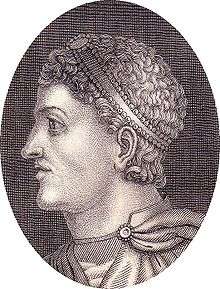 |
Theodosius I FLAVIVS THEODOSIVS AVGVSTVS |
January 11, 347 AD, Cauca, Hispania | Son-in-law of Valentinian I, appointed as Augustus for the east by Gratian after the death of Valens; became sole 'senior' Augustus after death of Valentinian II | January 1, 379 AD – January 17, 395 AD | January 17, 395 AD Natural causes |
16 years and 16 days |
| Arcadius FLAVIVS ARCADIVS AVGVSTVS EAST |
c. 377 AD, Hispania | Son of Theodosius I; appointed as 'junior' Augustus for the east by Theodosius in 383; became 'senior' Augustus for the east after his father's death | January 383 AD – May 1, 408 AD | May 1, 408 AD Natural causes |
25 years | |
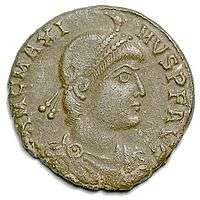 |
Magnus Maximus with Flavius Victor WEST |
c. 335 AD, Hispania | Usurper in the West; legitimized along with his son Victor by Theodosius I as emperors of Britannia and Gaul. | 383/384 AD – August 28, 388 AD | August 28, 388 AD Executed by Theodosius I in Aquileia after the Battle of the Save; Victor killed by Arbogast |
4/5 years |
 |
Honorius FLAVIVS HONORIVS AVGVSTVS WEST |
September 9, 384 AD, ? | Son of Theodosius I; appointed as 'junior' Augustus for the west by Theodosius in 393 (after the death of Valentinian II); became 'senior' Augustus for the west after his father's death | January 23, 393 AD – August 15, 423 AD | August 15, 423 AD Natural causes |
30 years, 6 months and 23 days |
 |
Theodosius II FLAVIVS THEODOSIVS AVGVSTVS EAST |
April 10, 401 AD, Constantinople? | Son of Arcadius; appointed as 'junior' Augustus for the east by Arcadius in 402; became 'senior' Augustus for the east after his father's death | January 402 AD – July 28, 450 AD | July 28, 450 AD Natural causes |
48 years |
| Constantine III with Constans II WEST |
? | Usurper who declared himself emperor in the west in 407, recognized as co-emperor by Honorius in 409. Elevated his son Constans II to co-emperor in 409, who was not recognized by Honorius. | 407/409 AD - August or September 411 AD | August or September 411 AD Executed by Constantius III |
2 years | |
| Constantius III FLAVIVS CONSTANTIVS AVGVSTVS WEST |
?, Naissus, Moesia Superior | Married to Theodosius I's daughter Galla Placidia, elevated to co-Augustus for the west by Honorius | February 8, 421 AD – September 2, 421 AD | September 2, 421 AD Natural causes |
6 months and 25 days | |
| Joannes WEST |
? | A senior civil servant under Honorius, proclaimed emperor by Castinus; not recognized by the Eastern Empire | August 27, 423 AD – May 425 AD | June or July 425 AD Defeated in battle by Theodosius II and Valentinian III, captured and executed |
2 years | |
 |
Valentinian III FLAVIVS PLACIDIVS VALENTINIANVS AVGVSTVS WEST |
July 2, 419 AD, Ravenna, Italia | Son of Constantius III, appointed Caesar for the west by Theodosius II after the death of Honorius, in opposition to the Johannes; became Augustus for the west after the defeat of Johannes | October 23, 424 AD – March 16, 455 AD | March 16, 455 AD Assassinated, possibly at the behest of Petronius Maximus |
30 years, 3 months and 24 days |
| Marcian FLAVIVS MARCIANVS AVGVSTVS EAST |
396, Thrace or Illyria | Nominated as successor (and husband) by Pulcheria, sister of Theodosius II | Summer 450 AD – January 457 AD | January 457 AD Natural causes |
7 years |
The last emperors of the Western Empire
| Portrait | Name | Birth | Succession | Reign | Death | Time in office |
|---|---|---|---|---|---|---|
| Petronius Maximus FLAVIVS ANICIVS PETRONIVS MAXIMVS AVGVSTVS |
c. 396 AD, ? | Son-in-law of Theodosius II, proclaimed himself emperor with the support of the army, after the death of Valentinian III. Not recognized by the Eastern Empire. | March 17, 455 AD – May 31, 455 AD | May 31, 455 AD Murdered, probably stoned to death by the Roman mob |
2 months and 14 days | |
| Avitus EPARCHIVS AVITVS AVGVSTVS |
c. 385 AD, ? | Magister militum under Petronius Maximus, proclaimed emperor by the Visigoth king Theoderic II after Petronius's death | July 9, 455 AD – October 17, 456 AD | after 17 October 456 AD Deposed by his Magister militum, Ricimer; became bishop of Placentia; murdered at some point afterwards |
1 year, 3 months and 8 days | |
| Majorian IVLIVS VALERIVS MAIORIANVS AVGVSTVS |
November 420 AD, ? | Appointed emperor by Ricimer | April 457 AD – August 2, 461 AD | August 7, 461 AD Deposed by his troops (probably at the behest of Ricimer); beheaded on the orders of Ricimer |
4 years | |
 |
Libius Severus LIBIVS SEVERVS AVGVSTVS |
?, Lucania, Italia | Appointed emperor by Ricimer. Not recognized by the Eastern Empire. | November 461 AD – August 465 AD | August 465 AD Probably poisoned by Ricimer |
4 years |
 |
Anthemius PROCOPIVS ANTHEMIVS AVGVSTVS |
c. 420 AD | Son-in-law of Marcian, appointed emperor by Ricimer, with the backing of the eastern emperor Leo I | April 12, 467 AD – July 11, 472 AD | July 11, 472 AD Executed by Ricimer |
5 years, 2 months and 29 days |
 |
Olybrius FLAVIVS ANICIVS OLYBRIVS AVGVSTVS |
c. 420 AD | Son-in-law of Valentinian III; appointed emperor by Ricimer. Not recognized by the Eastern Empire. | July 11, 472 AD – November 2, 472 AD | November 2, 472 AD Natural causes |
3 months and 22 days |
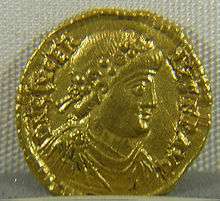 |
Glycerius FLAVIVS GLYCERIVS AVGVSTVS |
? | Appointed emperor by Gundobad (Ricimer's successor). Not recognized by the Eastern Empire. | March 473 AD – June 474 AD | after 480 AD Deposed by Julius Nepos, became Bishop of Salona, time and manner of death unknown |
1 year |
 |
Julius Nepos FLAVIVS IVLIVS NEPOS AVGVSTVS |
c. 430 AD | Nephew-in-law of the eastern emperor Leo I, appointed emperor in opposition to Glycerius | June 474 AD – August 28, 475 AD (in Italy); – spring 480 AD (in Gaul and Dalmatia) | 480 AD Deposed in Italy by Flavius Orestes, ruled in balance of Western Empire until assassination in 480. Maintained as figurehead in Italy by Odoacer to his death in 480. |
1 year/6 years |
 |
Romulus Augustulus ROMVLVS AVGVSTVS |
c. 460 AD, ?[12] | Appointed by his father, Flavius Orestes. Not recognized by the Eastern Empire. | October 31, 475 AD – September 4, 476 AD (in Italy) | Unknown. Regarded as emperor more from historical convention than accuracy, his rule never extended beyond portions of the Italian peninsula and was not recognized by Eastern Emperor Zeno. Deposed by Odoacer, who then ruled in the name of Julius Nepos until the latter's death in 480, which formally ended the separate western empire; most likely lived out his life on a private villa in obscurity. |
10 months and 4 days |
Eastern emperors
Leonid dynasty (457–518)
| Name | Reign | Comments | |
|---|---|---|---|
 | Leo I "the Thracian", "the Butcher", or "the Great" (Flavius Valerius Leo) | 7 February 457 – 18 January 474 | Born in Dacia ca. 400, and of Thracian Bessian origin, Leo became a low-ranking officer and served as an attendant of the Gothic commander-in-chief of the army, Aspar, who chose him as emperor on Marcian's death. He was the first emperor to be crowned by the Patriarch of Constantinople. His reign was marked by the pacification of the Danube frontier and peace with Persia, which allowed him to intervene in the affairs of the western empire, supporting candidates for the throne and dispatching an expedition to recover Carthage from the Vandals in 468. Initially a puppet of Aspar, Leo began promoting the Isaurians as a counterweight to Aspar's Goths, marrying his daughter Ariadne to the Isaurian leader Tarasicodissa (Zeno). With their support, in 471 Aspar was murdered and Gothic power over the army was broken.[13] |
-coin.jpg) | Leo II "the Little" (Flavius Leo) | 18 January – 17 November 474 | Born ca. 467, he was the grandson of Leo I by Leo's daughter Ariadne and her Isaurian husband, Zeno. Raised to Caesar and then co-emperor in autumn 473, soon after his accession Leo II crowned his father Zeno as co-emperor and effective regent. Died shortly after, possibly poisoned.[14] |
 | Zeno (Flavius Zeno) | 17 November 474 – 9 April 491 | Born ca. 425 in Isauria, originally named Tarasicodissa. As the leader of Leo I's Isaurian soldiers, he rose to comes domesticorum, married the emperor's daughter Ariadne and took the name Zeno, and played a crucial role in the elimination of Aspar and his Goths. He was named co-emperor by his son on 9 February 474, and became sole ruler upon the latter's death, but had to flee to his native country before Basiliscus in 475, regaining control of the capital in 476. Zeno concluded peace with the Vandals, saw off challenges against him by Illus and Verina, and secured peace in the Balkans by enticing the Ostrogoths under Theodoric the Great to migrate to Italy. Zeno's reign also saw the end of the western line of emperors. His pro-Monophysite stance made him unpopular and his promulgation of the Henotikon resulted in the Acacian Schism with the papacy.[15] |
 | Basiliscus ( Flavius Basiliscus) | 9 January 475 – August 476 | General and brother-in-law of Leo I, he seized power from Zeno but was again deposed by him. Died in 476/477 |
.jpg) | Anastasius I (Flavius Anastasius) | 11 April 491 – 9 July 518 | Son-in-law of Leo I, born ca. 430 at Dyrrhachium and of Illyrian origin, he was a palace official (silentiarius) when he was chosen as her husband and Emperor by Empress-dowager Ariadne. He was nicknamed "Dikoros", because of his heterochromia. Anastasius reformed the tax system and the Byzantine coinage and proved a frugal ruler, so that by the end of his reign he left a substantial surplus. His Monophysite sympathies led to wideaspread opposition, most notably the Revolt of Vitalian and the Acacian Schism. His reign was also marked by the first Bulgar raids into the Balkans and by a war with Persia over the foundation of Dara. He died childless.[16] |
Justinian dynasty (518–602)
| Name | Reign | Comments | |
|---|---|---|---|
 | Justin I (Flavius Iustinus) | July 518 – 1 August 527 | Born c. 450 at Bederiana (Justiniana Prima), Dardania to Thraco-Illyrian parents. Officer and commander of the Excubitors bodyguard under Anastasius I, he was elected by army and people upon the death of Anastasius I. |
.jpg) | Justinian I "the Great" (Flavius Petrus Sabbatius Iustinianus) | 1 August 527 – 13/14 November 565 | Born in 482/483 at Tauresium (Taor), Dardania. Nephew of Justin I, possibly raised to co-emperor on 1 April 527. Succeeded on Justin I's death. |
 | Justin II (Flavius Iustinus Iunior) | 14 November 565 – 5 October 578 | Born c. 520. Nephew of Justinian I, he seized the throne on the death of Justinian I with support of army and Senate. Became insane, hence in 573–574 under the regency of his wife Sophia, and in 574–578 under the regency of Tiberius Constantine. |
 | Tiberius II Constantine (Flavius Tiberius Constantinus) | 5 October 578 – 14 August 582 | Born c. 535, commander of the Excubitors, friend and adoptive son of Justin. Was named Caesar and regent in 574. Succeeded on Justin II's death. |
 | Maurice (Flavius Mauricius Tiberius) | 14 August 582 – 22 November 602 | Born in 539 at Arabissus, Cappadocia. Became an official and later a general. Married the daughter of Tiberius II and succeeded him upon his death. Named his son Theodosius as co-emperor in 590. Deposed by Phocas and executed on 27 November 602 at Chalcedon. |
Non-dynastic (602–610)
| Name | Reign | Comments | |
|---|---|---|---|
.jpg) | Phocas (Φωκᾶς, Flavius Phocas) | 23 November 602 – 4 October 610 | Subaltern in the Balkan army, he led a rebellion that deposed Maurice. Increasingly unpopular and tyrannical, he was deposed and executed by Heraclius. |
Heraclian dynasty (610–695)
| Name | Reign | Comments | |
|---|---|---|---|
 | Heraclius (Ἡράκλειος, Flavius Heraclius) | 5 October 610 – 11 February 641 | Born c. 575 as the eldest son of the Exarch of Africa, Heraclius the Elder. Began a revolt against Phocas in 609 and deposed him in October 610. Brought the Byzantine-Sassanid War of 602–628 to successful conclusion but was unable to stop the Muslim conquest of Syria. Officially replaced Latin with Greek as the language of administration. |
 | Constantine III formally Heraclius New Constantine (Ἡράκλειος νέος Κωνσταντῖνος, Heraclius Novus Constantinus) | 11 February – 24/26 May 641 | Born on 3 May 612 as the eldest son of Heraclius by his first wife Fabia Eudokia. Named co-emperor in 613, he succeeded to throne with his younger brother Heraklonas following the death of Heraclius. Died of tuberculosis, allegedly poisoned by Empress-dowager Martina. |
 | Heraklonas (Ἡρακλωνᾶς, Heraclianus) formally Constantine Heraclius (Κωνσταντίνος Ἡράκλειος, Constantinus Heraclius) | 11 February 641 – September 641 | Born in 626 to Heraclius' second wife Martina, named co-emperor in 638. Succeeded to throne with Constantine III following the death of Heraclius. Sole emperor after the death of Constantine III, under the regency of Martina, but was forced to name Constans II co-emperor by the army, and was deposed by the Senate in September 641. |
 | Constans II (Κῶνστας Β', Constantus II) formally Constantine "the Bearded", (Κωνσταντίνος ὁ Πωγωνάτος) | September 641 – 15 September 668 | Born on 7 November 630, the son of Constantine III. Raised to co-emperor in summer 641 after his father's death due to army pressure, he became sole emperor after the forced abdication of his uncle Heraklonas. Baptized Heraclius, he reigned as Constantine. "Constans" is his nickname. Moved his seat to Syracuse, where he was assassinated, possibly on the orders of Mezezius. |
 | Constantine IV "the Bearded" (Κωνσταντίνος Δ' ὁ Πωγωνάτος) | 15 September 668 – September 685 | Born in 652, he succeeded following the murder of his father Constans II. Erroneously called "Constantine the Bearded" by historians through confusion with his father. He repelled the First Arab Siege of Constantinople, and died of dysentery. |
| Justinian II "the Slit-nosed" (Ἰουστινιανὸς Β' ὁ Ῥινότμητος) | September 685 – 695 | Born in 669, he was named co-emperor in 681 and became sole emperor upon Constantine IV's death. Deposed by military revolt in 695, mutilated (hence his surname) and exiled to Cherson, whence he recovered his throne in 705. | |
Twenty Years' Anarchy (695–717)
| Name | Reign | Comments | |
|---|---|---|---|
 | Leontios (Λεόντιος) | 695–698 | General from Isauria, he deposed Justinian II and was overthrown in another revolt in 698. He was executed in February 706. |
 | Tiberius III Apsimar (Τιβέριος Γ' Ἀψίμαρος) | 698–705 | Admiral of Germanic origin, originally named Apsimar. He rebelled against Leontios after a failed expedition. Reigned under the name of Tiberius until deposed by Justinian II in 705. Executed in February 706. |
| Justinian II "the Slit-nosed" (Ἰουστινιανὸς Β' ὁ Ῥινότμητος) | August 705 – December 711 | Returned on the throne with Bulgar support. Named son Tiberius as co-emperor in 706. Deposed and killed by military revolt. | |
 | Philippikos Bardanes (Φιλιππικὸς Βαρδάνης) | December 711 – 3 June 713 | A general of Armenian origin, he deposed Justinian II and was in turn overthrown by a revolt of the Opsician troops. |
 | Anastasios II (Ἀναστάσιος Β') | June 713 – November 715 | Originally named Artemios. A bureaucrat and secretary under Philippikos, he was raised to the purple by the soldiers who overthrew Philippikos. Deposed by another military revolt, he led an abortive attempt to regain the throne in 718 and was killed. |
 | Theodosios III (Θεοδόσιος Γ') | May 715 – 25 March 717 | A fiscal official, he was proclaimed emperor by the rebellious Opsician troops. Entered Constantinople in November 715. Abdicated following the revolt of Leo the Isaurian and became a monk. |
Isaurian dynasty (717–802)
| Name | Reign | Comments | |
|---|---|---|---|
 | Leo III "the Isaurian" (Λέων Γ΄ ὁ Ἴσαυρος) | 25 March 717 – 18 June 741 | Born c. 685 in Germanikeia, Commagene, he became a general. Rose in rebellion and secured the throne in spring 717. Repelled the Second Arab Siege of Constantinople and initiated the Byzantine Iconoclasm. |
 | Constantine V "the Dung-named" (Κωνσταντίνος Ε΄ ὁ Κοπρώνυμος) | 18 June 741 – 14 September 775 | Born in July 718, the only son of Leo III. Co-emperor since 720, he succeeded upon his father's death. After overcoming the usurpation of Artabasdos, he continued his father's iconoclastic policies and won several victories against the Arabs and the Bulgars. He is given the surname "the Dung-named" by hostile later chroniclers. |
| Artabasdos (Ἀρτάβασδος) | June 741/742 – 2 November 743 | General and son-in-law of Leo III, Count of the Opsician Theme. Led a revolt that secured Constantinople, but was defeated and deposed by Constantine V, who blinded and tonsured him. | |
 | Leo IV "the Khazar" (Λέων Δ΄ ὁ Χάζαρος) | 14 September 775 – 8 September 780 | Born on 25 January 750 as the eldest son of Constantine V. Co-emperor since 751, he succeeded upon his father's death. |
 | Constantine VI (Κωνσταντίνος ΣΤ΄) | 8 September 780 – August 797 | Born in 771, the only child of Leo IV. Co-emperor in 776, sole emperor upon Leo's death in 780, until 790 under the regency of his mother, Irene of Athens. He was overthrown on Irene's orders, blinded and imprisoned, probably dying of his wounds shortly after. |
.jpg) | Irene of Athens (Εἰρήνη ἡ Αθηναία) | August 797 – 31 October 802 | Born c. 752 in Athens, she married Leo IV. Regent for her son Constantine VI in 780–790, she overthrew him in 797 and became empress-regnant. Deposed in a palace coup in 802, she was exiled and died on 9 August 803. |
Nikephorian dynasty (802–813)
| Name | Reign | Comments | |
|---|---|---|---|
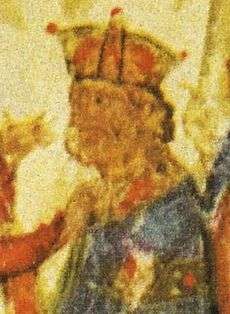 | Nikephoros I "the Logothete" (Νικηφόρος Α΄ ὁ Λογοθέτης) | 31 October 802 – 26 July 811 | General Logothete (finance minister) under Irene, led initially successful campaigns against the Bulgars but was killed at the Battle of Pliska. |
 | Staurakios (Σταυράκιος) | 26 July 811 – 2 October 811 | Only son of Nikephoros I, crowned co-emperor in December 803. Succeeded on his father's death; however, he had been heavily wounded at Pliska and left paralyzed. He was forced to resign, and retired to a monastery where he died soon after. |
 | Michael I Rangabe (Μιχαὴλ Α΄ Ραγγαβὲ) | 2 October 811 – 22 June 813 | Son-in-law of Nikephoros I, he succeeded Staurakios on his abdication. Resigned after the revolt under Leo the Armenian and retired to a monastery, where he died on 11 January 844. Reigned with eldest son Theophylact as co-emperor. |
Non-dynastic (813–820)
| Name | Reign | Comments | |
|---|---|---|---|
 | Leo V "the Armenian" (Λέων Ε' ὁ Ἀρμένιος) | 11 July 813 – 25 December 820 | General of Armenian origin, born c. 775. He rebelled against Michael I and became emperor. Appointed his son Symbatios co-emperor under the name of Constantine on Christmas 813. Revived Byzantine Iconoclasm. Murdered by a conspiracy led by Michael the Amorian. |
Amorian dynasty (820–867)
| Name | Reign | Comments | |
|---|---|---|---|
 | Michael II "the Amorian" (Μιχαὴλ Β΄ ὁ ἐξ Ἀμορίου) | 25 December 820 – 2 October 829 | Born in 770 at Amorium, he became an army officer. A friend of Leo V, he was raised to high office but led the conspiracy that murdered him. Survived the rebellion of Thomas the Slav, lost Crete to the Arabs and faced the beginning of the Muslim conquest of Sicily, reinforced iconoclasm. |
 | Theophilos (Θεόφιλος) | 2 October 829 – 20 January 842 | Born in 813, as the only son of Michael II. Co-emperor since 821, he succeeded on his father's death. |
 | Michael III "the Drunkard" (Μιχαὴλ Γ΄ ὁ Μέθυσος) | 20 January 842 – 23 September 867 | Born on 19 January 840, he succeeded on Theophilos' death. Under the regency of his mother Theodora until 856, and under the effective control of his uncle Bardas in 862–866. Ended iconoclasm. Murdered by Basil the Macedonian. A pleasure-loving ruler, he was nicknamed "the Drunkard" by later, pro-Basil chroniclers . |
Macedonian dynasty (867–1056)
| Name | Reign | Comments | |
|---|---|---|---|
| Basil I "the Macedonian" (Βασίλειος Α΄ ὁ Μακεδὸν) | 867 – 2 August 886 | Born in the Theme of Macedonia ca. 811, he rose in prominence through palace service, becoming a favourite of Michael III. He overthrew Michael and established the Macedonian dynasty. He led successful wars in the East against the Arabs and the Paulicians, and recovered southern Italy for the Empire. | |
 | Leo VI "the Wise" (Λέων ΣΤ΄ ὁ Σοφὸς) | 886 – 11 May 912 | Born on 19 September 866, likely either son of Basil I or Michael III, Leo was known for his erudition. His reign saw a height in Saracen (Muslim) naval raids, culminating in the Sack of Thessalonica, and was marked by unsuccessful wars against the Bulgarians under Simeon I. |
 | Alexander (Ἀλέξανδρος) | 11 May 912 – 6 June 913 | Son of Basil I, Alexander was born in 870 and raised to co-emperor in 879. Sidelined by Leo VI, Alexander dismissed his brother's principal aides on his accession. He died of exhaustion after a polo game. |
 | Constantine VII "the Purple-born" (Κωνσταντίνος Ζ΄ ὁ Πορφυρογέννητος) | 6 June 913 – 9 November 959 | The son of Leo VI, he was born on 17/18 May 905 and raised to co-emperor on 15 May 908. His early reign was dominated by successive regencies, first by his mother, Zoe Karbonopsina, and Patriarch Nicholas Mystikos, and from 919 by the admiral Romanos Lekapenos, who wedded his daughter to Constantine and was crowned senior emperor in 920. Constantine was sidelined during the Lekapenos regime, but asserted his control by deposing Romanos's sons in early 945. His reign was marked by struggles with Sayf al-Dawla in the East and an unsuccessful campaign against Crete, and pro-aristocratic policies that saw a partial reversal of Lekapenos' legislation against the dynatoi. He is notable for his promotion of the "Macedonian Renaissance", sponsoring encyclopaedic works and histories. He was a prolific writer himself, best remembered for the manuals on statecraft (De administrando imperio) and ceremonies (De ceremoniis) he compiled for his son, Romanos II.[17] |
| Romanos I Lekapenos (Ρωμανὸς Α΄ Λεκαπηνὸς) | 17 December 920 – 16 December 944 | An admiral of lowly origin, Romanos rose to power as a protector of the young Constantine VII against the general Leo Phokas the Elder. After becoming the emperor's father-in-law, he successively assumed higher offices until he crowned himself senior emperor. His reign was marked by the end of warfare with Bulgaria and the great conquests of John Kourkouas in the East. Romanos promoted his sons Christopher, Stephen and Constantine as co-emperors over Constantine VII, but was himself overthrown by the latter two and confined to an island as a monk. He died there on 15 June 948. | |
| Romanos II "the Purple-born" (Ρωμανὸς Β΄ ὁ Πορφυρογέννητος) | 9 November 959 – 15 March 963 | The only surviving son of Constantine VII, he was born on 15 March 938 and succeeded his father on the latter's death. He ruled until his own death, although the government was led mostly by the eunuch Joseph Bringas. His reign was marked by successful warfare in the East against Sayf al-Dawla and the recovery of Crete by general Nikephoros Phokas. | |
 | Nikephoros II Phokas (Νικηφόρος Β΄ Φωκᾶς) | 16 August 963 – 11 December 969 | The most successful general of his generation, Nikephoros II was born ca. 912 to the powerful Phokas clan. After the death of Romanos II, he rose to the throne with the support of the army and people as regent for the young emperors Basil II and Constantine VIII, marrying the empress-dowager Theophano. Throughout his reign he led campaigns in the East, conquering much of Syria. He was murdered by his nephew and one-time associate John Tzimiskes. |
 | John I Tzimiskes (Ἰωάννης Α΄ Κουρκούας ὁ Τσιμισκὴς) | 11 December 969 – 10 January 976 | Nephew of Nikephoros Phokas, Tzimiskes was born ca. 925. A successful general, he fell out with his uncle and led a conspiracy of disgruntled generals who murdered him. Tzimiskes succeeded Nikephoros as emperor and regent for the young sons of Romanos II. As ruler, Tzimiskes crushed the Rus' in Bulgaria and ended the Bulgarian tsardom before going on to campaign in the East, where he died. |
 | Basil II "the Bulgar-Slayer" (Βασίλειος Β΄ ὁ Βουλγαροκτόνος) | 10 January 976 – 15 December 1025 | Eldest son of Romanos II, Basil was born in 958. The first decade of his reign was marked by rivalry with the powerful Basil Lekapenos, an unsuccessful war against Bulgaria, and rebellions by generals in Asia Minor. Basil solidified his position through a marriage alliance with Vladimir I of Kiev, and after suppressing the revolts, he embarked on his conquest of Bulgaria. Bulgaria was finally subdued in 1018 after over 20 years of war, interrupted only by sporadic warfare in Syria against the Fatimids. Basil also expanded Byzantine control over most of Armenia. His reign is widely considered as the apogee of medieval Byzantium. |
| Constantine VIII "the Purple-born" (Κωνσταντίνος Η΄ ὁ Πορφυρογέννητος) | 15 December 1025 – 15 November 1028 | The second son of Romanos II, Constantine was born in 960 and raised to co-emperor in March 962. During the rule of Basil II, he spent his time in idle pleasure. During his short reign he was an indifferent ruler, easily influenced by his courtiers and suspicious of plots to depose him, especially among the military aristocracy, many of whom were blinded and exiled. On his deathbed, he chose Romanos Argyros as husband for his daughter Zoe.[18] | |
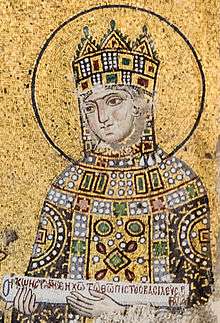 | Zoe "the Purple-born" (Ζωὴ Πορφυρογέννητη) | 15 November 1028 – June 1050 | The daughter of Constantine VIII, she succeeded on her father's death, as the only surviving member of the Macedonian dynasty, along with her sister Theodora. Her three husbands, Romanos III (1028–1034), Michael IV (1034–1041) and Constantine IX (1042–1050) ruled alongside her. |
| Romanos III Argyros (Ρωμανὸς Γ΄ Ἀργυρὸς) | 15 November 1028 – 11 April 1034 | Born in 968, the elderly aristocrat Romanos was chosen by Constantine VIII on his deathbed as Zoe's husband and succeeded on the throne after Constantine's death a few days later. | |
| Michael IV "the Paphlagonian" (Μιχαὴλ Δ΄ ὁ Παφλαγὼν) | 11 April 1034 – 10 December 1041 | Born in 1010, he became a lover of Zoe even while Romanos III was alive, and succeeded him upon his death as her husband and emperor. Aided by his older brother, the eunuch John the Orphanotrophos, his reign was moderately successful against internal rebellions, but his attempt to recover Sicily failed. He died after a long illness. | |
| Michael V "the Caulker" (Μιχαὴλ Ε΄ ὁ Καλαφάτης) | 10 December 1041 – 20 April 1042 | Born in 1015, he was the nephew and adopted son of Michael IV. During his reign he tried to sideline Zoe, but a popular revolt forced him to restore her as empress on 19 April 1042, along with her sister Theodora. He was deposed the next day, castrated and tonsured, dying on 24 August 1042. | |
| Theodora (Θεοδώρα) | 19 April 1042 – after 31 August 1056 | The younger sister of Zoe, born in 984, she was raised as co-ruler on 19 April 1042. After Zoe married her third husband, Constantine IX, in June 1042, Theodora was again sidelined. After Zoe died in 1050 and Constantine in 1055, Theodora assumed full governance of the Empire and reigned until her death. She nominated Michael VI as her successor. | |
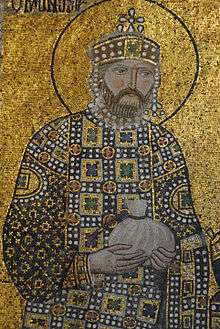 | Constantine IX Monomachos (Κωνσταντίνος Θ΄ Μονομάχος) | 11 June 1042 – 7/8 or 11 January 1055 | Born ca. 1000 of noble origin, he had an undistinguished life but was exiled to Lesbos by Michael IV, returning when he was chosen as Zoe's third husband. Constantine supported the mercantile classes and favoured the company of intellectuals, thereby alienating the military aristocracy. A pleasure-loving ruler, he lived an extravagant life with his favourite mistresses and endowed a number of monasteries, chiefly the Nea Moni of Chios and the Mangana Monastery. His reign was marked by invasions by the Pechenegs in the Balkans and the Seljuk Turks in the East, the revolts of George Maniakes and Leo Tornikios, and the Great Schism between the patriarchates of Rome and Constantinople.[19] |
Non-dynastic (1056–1057)
| Name | Reign | Comments | |
|---|---|---|---|
| Michael VI Bringas, "Stratiotikos" or "the Old" (Μιχαὴλ ΣΤ΄ Βρίγγας, ὁ Στρατιωτικός, ὁ Γέρων) | September 1056 – 31 August 1057 | A court bureaucrat and military logothete (hence his first sobriquet). Deposed by military revolt under Isaac Komnenos, he retired to a monastery where he died in 1059. | |
Komnenid dynasty (1057–1059)
| Name | Reign | Comments | |
|---|---|---|---|
| Isaac I Komnenos (Ἰσαάκιος Α΄ Κομνηνὸς) | 5 June 1057 – 22 November 1059 | Born c. 1005. A successful general, he rose in revolt leading the eastern armies and was declared Emperor; he was recognized after the abdication of Michael VI on 31 August 1057. He resigned in 1059 and died c. 1061. | |
Doukid dynasty (1059–1081)
| Name | Reign | Comments | |
|---|---|---|---|
| Constantine X Doukas (Κωνσταντίνος Ι΄ Δούκας) | 24 November 1059 – 22 May 1067 | Born in 1006, he became a general and close ally of Isaac Komnenos, and succeeded him as emperor on his abdication. Named his sons Michael, Andronikos and Konstantios as co-emperors | |
 | Michael VII Doukas (Μιχαὴλ Ζ΄ Δούκας) | 22 May 1067 – 24 March 1078 | Born in 1050 as the eldest son of Constantine X. Co-emperor since 1059, he succeeded on his father's death. Due to his minority he was under the regency of his mother, Eudokia Makrembolitissa, in 1067–1068, and relegated to junior emperor under her second husband Romanos IV Diogenes in 1068–1071. Senior emperor in 1071–1078, he named his son Constantine co-emperor alongside his brothers. He abdicated before the revolt of Nikephoros Botaneiates, retired to a monastery and died c. 1090. |
| Romanos IV Diogenes (Ρωμανὸς Δ΄ Διογένης) | 1 January 1068 – 24 October 1071 | Born in 1032, a successful general he married empress-dowager Eudokia Makrembolitissa and became senior emperor as guardian of her sons by Constantine X. Deposed by the Doukas partisans after the Battle of Manzikert, blinded in June 1072 and exiled. He died soon after. | |
 | Nikephoros III Botaneiates (Νικηφόρος Γ΄ Βοτανειάτης) | 31 March 1078 – 4 April 1081 | Born in 1001, he was the strategos of the Anatolic Theme. He rebelled against Michael VII and was welcomed into the capital. He weathered several revolts, but was overthrown by the Komnenos clan. He retired to a monastery where he died on 10 December of the same year (1081). |
Komnenid dynasty (1081–1185)
| Name | Reign | Comments | |
|---|---|---|---|
 | Alexios I Komnenos (Ἀλέξιος Α' Κομνηνὸς) | 4 April 1081 – 15 August 1118 | Born in 1056, a nephew of Isaac I Komnenos. A distinguished general, he overthrew Nikephoros III. His reign was dominated by wars against the Normans and the Seljuk Turks, as well as the arrival of the First Crusade and the establishment of independent Crusader states. He retained Constantine Doukas as co-emperor until 1087 and named his eldest son John co-emperor in 1092. |
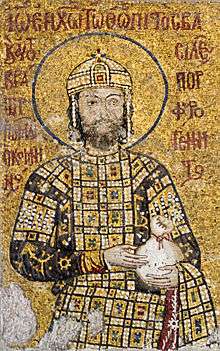 | John II Komnenos (Ἰωάννης Β' Κομνηνὸς) | 15 August 1118 – 8 April 1143 | Born on 13 September 1087 as the eldest son of Alexios I. Co-emperor since 1092, he succeeded upon his father's death. His reign was focused on wars with the Turks. A popular and frugal ruler, he was known as "John the Good". Named his eldest son Alexios co-emperor in 1122, but he died before him. |
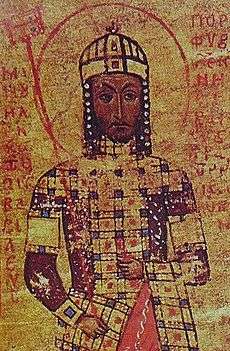 | Manuel I Komnenos (Μανουὴλ Α' Κομνηνὸς) | 1143 – 24 September 1180 | Born on 28 November 1118 as the third and youngest son of John II, he was chosen as emperor over his elder brother Isaac by his father on his deathbed. An energetic ruler, he launched campaigns against the Turks, humbled Hungary, achieved supremacy over the Crusader states, and tried unsuccessfully to recover Italy. His extravagance and constant campaigning, however, depleted the Empire's resources. |
 | Alexios II Komnenos (Ἀλέξιος B' Κομνηνὸς) | 24 September 1180 – October 1183 | Born on 14 September 1169 as the only son of Manuel I. In 1180–1182 under the regency of his mother, Maria of Antioch. She was overthrown by Andronikos I Komnenos, who became co-emperor and finally had Alexios II deposed and killed. |
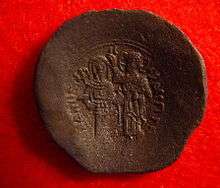 | Andronikos I Komnenos (Ἀνδρόνικος Α' Κομνηνὸς) | 1183 – 11 September 1185 | Born c. 1118, a nephew of John II by his brother Isaac. A general, he was imprisoned for conspiring against John II, but escaped and spent 15 years in exile in various courts in eastern Europe and the Middle East. He seized the regency from Maria of Antioch in 1182 and subsequently throne from his nephew Alexios II. An unpopular ruler, he was overthrown and lynched in a popular uprising. |
Angelid dynasty (1185–1204)
| Name | Reign | Comments | |
|---|---|---|---|
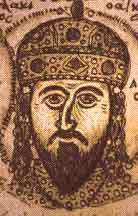 | Isaac II Angelos (Ἰσαάκιος Β' Ἄγγελος) | 1185–1195 | Born in September 1156, Isaac came to the throne at the head of a popular revolt against Andronikos I. His reign was marked by revolts and wars in the Balkans, especially against a resurgent Bulgaria. He was deposed, blinded and imprisoned by his elder brother, Alexios III. |
 | Alexios III Angelos (Ἀλέξιος Γ' Ἄγγελος) | 1195 – 17/18 July 1203 | Born in 1153, Alexios was the elder brother of Isaac II. His reign was marked by misgovernment and the increasing autonomy of provincial magnates. He was deposed by the Fourth Crusade and fled Constantinople, roaming Greece and Asia Minor, searching for support to regain his throne. He died in Nicaean captivity in 1211. |
 | Isaac II Angelos (Ἰσαάκιος Β' Ἄγγελος) | 18 July 1203 – 27/28 January 1204 | Restored to his throne by the Crusaders, actual rule fell to his son Alexios IV. Due to their failure to deal with the Crusaders' demands, he was deposed by Alexios V Doukas in January 1204 and died on 28 January 1204, perhaps of poison. |
 | Alexios IV Angelos (Ἀλέξιος Δ' Ἄγγελος) | 1 August 1203 – 27/28 January 1204 | Born in 1182, the son of Isaac II. He enlisted the Fourth Crusade to return his father to the throne, and reigned alongside his restored father. Due to their failure to deal with the Crusaders' demands, he was deposed by Alexios V Doukas in January 1204, and was strangled on 8 February. |
| Alexios V Doukas "Mourtzouphlos" (Ἀλέξιος Ε' Δούκας ὁ Μούρτζουφλος) | 5 February 1204 – 13 April 1204 | Born in 1140, the son-in-law of Alexios III and a prominent aristocrat, he deposed Isaac II and Alexios IV in a palace coup. He tried to repel the Crusaders, but they captured Constantinople forcing Mourtzouphlos to flee. He joined the exiled Alexios III, but was later blinded by the latter. Captured by the Crusaders, he was executed in December 1205. | |
Laskarid dynasty (Empire of Nicaea, 1204–1261)
| Name | Reign | Comments | |
|---|---|---|---|
 | Theodore I Laskaris (Θεόδωρος Α΄ Λάσκαρις) | 1205– December 1221/1222 | Born c. 1174, he rose to prominence as a son-in-law of Alexios III. His brother Constantine Laskaris was elected emperor by the citizens of Constantinople on the day the city fell to the Crusaders; he later fled to Nicaea, where Theodore organized the Greek resistance to the Latins. Proclaimed emperor after Constantine's death in 1205, Theodore was crowned only in 1208. He managed to stop the Latin advance in Asia and to repel Seljuk attacks, establishing the Empire of Nicaea as the strongest of the Greek successor states. |
 | John III Doukas Vatatzes (Ἰωάννης Γ' Δούκας Βατάτζης) | 15 December 1221/1222– 3 November 1254 | Born c. 1192, he became the son-in-law and successor of Theodore I in 1212. A capable ruler and soldier, he expanded his state in Bithynia, Thrace and Macedonia at the expense of the Latin Empire, Bulgaria and the rival Greek state of Epirus. |
 | Theodore II Laskaris (Θεόδωρος Β' Λάσκαρις) | 3 November 1254– 18 August 1258 | Born in 1221/1222 as the only son of John III, he succeeded on his father's death. His reign was marked by his hostility towards the major houses of the aristocracy, and by his victory against Bulgaria and the subsequent expansion into and Albania. |
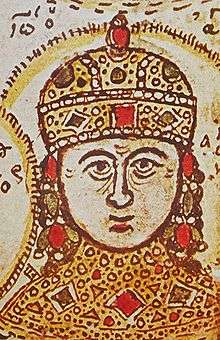 | John IV Laskaris (Ἰωάννης Δ' Λάσκαρις) | 18 August 1258– 25 December 1261 | Born on 25 December 1250 as the only son of Theodore II, he succeeded on his father's death. Due to his minority, the regency was exercised at first by George Mouzalon until his assassination, and then by Michael Palaiologos, who within months was crowned senior emperor. After the recovery of Constantinople in August 1261, Palaiologos sidelined John IV completely, had him blinded and imprisoned. John IV died c. 1305. |
Palaiologan dynasty (restored to Constantinople, 1261–1453)
| Name | Reign | Comments | |
|---|---|---|---|
.jpg) | Michael VIII Palaiologos (Μιχαὴλ Η' Παλαιολόγος) | 1 January 1259– 11 December 1282 | Born in 1223, great-grandson of Alexios III, grandnephew of John III by marriage. Senior emperor alongside John IV in 1259, sole emperor since 25 December 1261. |
.jpg) | Andronikos II Palaiologos (Ἀνδρόνικος Β' Παλαιολόγος) | 11 December 1282– 24 May 1328 | Son of Michael VIII, he was born on 25 March 1259. Named co-emperor in September 1261, crowned in 1272, he succeeded as sole emperor on Michael's death. Favouring monks and intellectuals, he neglected the army, and his reign saw the collapse of the Byzantine position in Asia Minor. He named his son Michael IX co-emperor. In a protracted civil war, he was first forced to recognize his grandson Andronikos III as co-emperor and was then deposed outright. He died on 13 February 1332. |
 | Andronikos III Palaiologos (Ἀνδρόνικος Γ' Παλαιολόγος) | 24 May 1328– 15 June 1341 | Son of Michael IX, he was born on 25 March 1297 and named co-emperor in 1316. Rival emperor since July 1321, he deposed his grandfather Andronikos II in 1328 and ruled as sole emperor until his death. Supported by John Kantakouzenos, his reign saw defeats against the Ottoman emirate but successes in Europe, where Epirus and Thessaly were recovered. |
 | John V Palaiologos (Ἰωάννης Ε' Παλαιολόγος) | 15 June 1341– 12 August 1376 | Only son of Andronikos III, he had not been crowned co-emperor or declared heir at his father's death, a fact which led to the outbreak of a destructive civil war between his regents and his father's closest aide, John VI Kantakouzenos, who was crowned co-emperor. The conflict ended in 1347 with Kantakouzenos recognized as senior emperor, but he was deposed by John V in 1354, during another civil war. Matthew Kantakouzenos, raised by John VI to co-emperor, was also deposed in 1357. John V appealed to the West for aid against the Ottomans, but in 1371 he was forced to recognize Ottoman suzerainty. He was deposed in 1376 by his son Andronikos IV. |
.jpg) | John VI Kantakouzenos (Ἰωάννης ΣΤ' Καντακουζηνὸς) | 8 February 1347– 4 December 1354 | A maternal relative of the Palaiologoi, he was declared co-emperor on 26 October 1341, and was recognized as senior emperor for ten years after the end of the civil war on 8 February 1347. Deposed by John V in 1354, he became a monk, dying on 15 June 1383. |
 | Andronikos IV Palaiologos (Ἀνδρόνικος Δ΄ Παλαιολόγος) | 12 August 1376– 1 July 1379 | Son of John V and grandson of John VI, he was born on 2 April 1348 and raised to co-emperor c. 1352. He deposed his father on 12 August 1376 and ruled until overthrown in turn in 1379. He was again recognized as co-emperor in 1381 and given Selymbria as an appanage, dying there on 28 June 1385. |
 | John V Palaiologos (Ἰωάννης Ε' Παλαιολόγος) | 1 July 1379– 14 April 1390 | Restored to senior emperor, he was reconciled with Andronikos IV in 1381, re-appointing him co-emperor. He was overthrown again in 1390 by his grandson, John VII. |
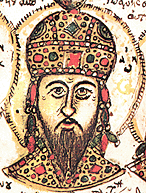 | John VII Palaiologos (Ἰωάννης Ζ' Παλαιολόγος) | 14 April 1390– 17 September 1390 | Son of Andronikos IV, he was born in 1370, and named co-emperor under his father in 1377–79. He usurped the throne from his grandfather John V for five months in 1390, but with Ottoman mediation he was reconciled with John V and his uncle, Manuel II. He held Constantinople against the Ottomans in 1399–1402, and was then given Thessalonica as an appanage, which he governed until his death on 22 September 1408. |
 | John V Palaiologos (Ἰωάννης Ε' Παλαιολόγος) | 17 September 1390– 16 February 1391 | Restored to senior emperor, he ruled until his death in February 1391. |
 | Manuel II Palaiologos (Μανουὴλ Β' Παλαιολόγος) | 16 February 1391– 21 July 1425 | Second son of John V, he was born on 27 June 1350. Raised to co-emperor in 1373, he became senior emperor on John V's death and ruled until his death. He journeyed to the West European courts seeking aid against the Turks, and was able to use the Ottoman defeat in the Battle of Ankara to regain some territories and throw off his vassalage to them. |
 | John VIII Palaiologos (Ἰωάννης Η' Παλαιολόγος) | 21 July 1425– 31 October 1448 | Eldest surviving son of Manuel II, he was born on 18 December 1392. Raised to co-emperor c. 1416, he succeeded his father on his death. Seeking aid against the resurgent Ottomans, he ratified the Union of the Churches in 1439. |
 | Constantine XI Palaiologos (Κωνσταντίνος ΙΑ' Παλαιολόγος) | 6 January 1449– 29 May 1453 | The fourth son of Manuel II, he was born on 8 February 1405. As Despot of the Morea since 1428, he distinguished himself in campaigns that annexed the Principality of Achaea and brought the Duchy of Athens under temporary Byzantine suzerainty, but was unable to repel Turkish attacks under Turahan Bey. As the eldest surviving brother, he succeeded John VIII after the latter's death. Facing the designs of the new Ottoman sultan, Mehmed II, on Constantinople, Constantine acknowledged the Union of the Churches and made repeated appeals for help to the West, but in vain. Refusing to surrender the city, he was killed during the final Ottoman attack on 29 May 1453.[20] |
Palaiologan dynasty (claimants in exile)
| Picture | Name | Status | Birth | Emperor from | Emperor until | Death |
|---|---|---|---|---|---|---|
| Demetrios Palaiologos (Δημήτριος Παλαιολόγος) | Son of Manuel II, brother of John VIII and Constantine XI | c. 1407 | 1453 | 1460 | 1470 | |
 | Thomas Palaiologos (Θωμᾶς Παλαιολόγος) | Son of Manuel II, brother of John VIII and Constantine XI | c. 1409 | 1453 | 12 May 1465 | 12 May 1465 |
| Andreas Palaiologos (Ἀνδρέας Παλαιολόγος) | Son of Thomas | c. 1453 | 12 May 1465 | 1502 | 1502 |
See also
Notes
- 1 2 Rubicon. Holland, T. Abacus, 978-0349115634
- ↑ Mos, Henry St.L. B., The Birth of the Middle Ages 395-814, Clarendon Press, London (1935); reprint by Folio Society, London (1998); p. 17)
- ↑ Chester G. Starr, A History of the Ancient World, Second Edition. Oxford University Press, 1974. pp. 670–678.
- ↑ Asimov, [title?], p. 198.
- ↑ http://online.wsj.com/article/SB10001424052748704615504576172512424600444.html
- ↑ Lee, pp. 163–164.
- ↑ Goldsworthy, pp. 425–440
- ↑ Breeze & Dobson, pp. 251–255
- ↑ Moss, Henry, The Birth of the Middle Ages Clarendon Press (London) 1935; Folio Society reprint (London) 1998; pp. 24-28, 281-284.
- ↑ "Roman Emperors After Theodosius I". Retrieved 30 September 2014.
- ↑ The other claimants for the throne in the Year of the Five Emperors were Pescennius Niger and Clodius Albinus, supported by the Syrian and British legions respectively. Although not completely defeated until 197 AD, they were not formally accepted by the senate and were therefore not technically reigning emperors.
- ↑ Romulus Agustulus biographic details.
- ↑ Gregory, Timothy E.; Cutler, Anthony (1991). "Leo I". In Kazhdan, Alexander P. Oxford Dictionary of Byzantium. New York; Oxford: Oxford University Press. pp. 1206–1207. ISBN 978-0-19-504652-6.
- ↑ Kazhdan, Alexander P. (1991). "Leo II". In Kazhdan, Alexander P. Oxford Dictionary of Byzantium. New York; Oxford: Oxford University Press. pp. 1207–1208. ISBN 978-0-19-504652-6.
- ↑ Gregory, Timothy E. (1991). "Zeno". In Kazhdan, Alexander P. Oxford Dictionary of Byzantium. New York; Oxford: Oxford University Press. p. 2223. ISBN 978-0-19-504652-6.
- ↑ Gregory, Timothy E. (1991). "Anastasios I". In Kazhdan, Alexander P. Oxford Dictionary of Byzantium. New York; Oxford: Oxford University Press. pp. 86–87. ISBN 978-0-19-504652-6.
- ↑ Kazhdan, Alexander; Cutler, Anthony (1991). "Constantine VII Porphyrogennetos". In Kazhdan, Alexander P. Oxford Dictionary of Byzantium. New York; Oxford: Oxford University Press. pp. 502–503. ISBN 978-0-19-504652-6.
- ↑ Brand, Charles M.; Cutler, Anthony (1991). "Constantine VIII". In Kazhdan, Alexander P. Oxford Dictionary of Byzantium. New York; Oxford: Oxford University Press. pp. 503–504. ISBN 978-0-19-504652-6.
- ↑ Brand, Charles M.; Cutler, Anthony (1991). "Constantine IX Monomachos". In Kazhdan, Alexander P. Oxford Dictionary of Byzantium. New York; Oxford: Oxford University Press. p. 504. ISBN 978-0-19-504652-6.
- ↑ Talbot, Alice-Mary (1991). "Constantine XI Palaiologos". In Kazhdan, Alexander P. Oxford Dictionary of Byzantium. New York; Oxford: Oxford University Press. p. 505. ISBN 978-0-19-504652-6.
References
Ancient sources
- Tacitus, The Annals of Imperial Rome, Penguin Classics, Michael Grant Publications Ltd, 1971, Reprinted 1985, ISBN 0-14-044060-7
Modern sources
- David J. Breeze, Brian Dobson Hadrian's Wall 4th Edition, Penguin, 2000, ISBN 0-14-027182-1
- Clive Carpenter, The Guinness Book of Kings Rulers and Statesmen, Guinness Superlatives Ltd, 1978, ISBN 0-900424-46-X
- Adrian Goldsworthy, The Fall of the West, Phoenix, 2010, ISBN 978-0-7538-2692-8
- Min Lee (editor), Larousse Pockect Guide Kings and Queens, Larousse, 1995 ISBN 0-7523-0032-6
- Martha Ross, Rulers and Governments of the World, Vol.1 Earliest Times to 1491, Bowker, 1978, ISBN 0-85935-021-5
- Chris Scarre, Brandon Shaw, Chronicle of the Roman Emperors, Thames & Hudson, 1995, Reprinted 2001, ISBN 0-500-05077-5
- R. F. Tapsell, Monarchs Rulers Dynasties and Kingdoms of The World, Thames & Hudson, 1981, Reprinted 1987, ISBN 0-500-27337-5
External links
| Wikimedia Commons has media related to Roman Emperors. |
- Biographies of Roman Emperors.
- List of the Roman Emperors 27 BC – 395 AD
- Portraits and fact files
- The Roman Law Library by Yves Lassard and Alexandr Koptev.
- Timeline of Roman Emperors and Empresses
| |||||||||||||||||||||